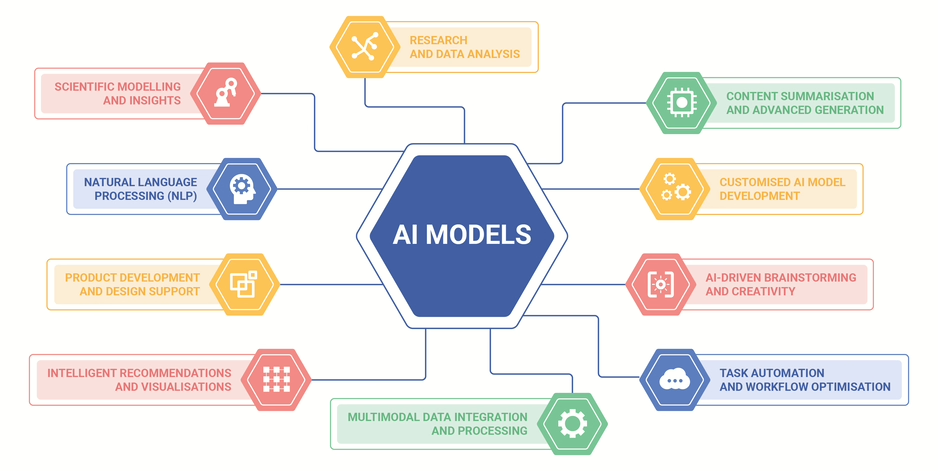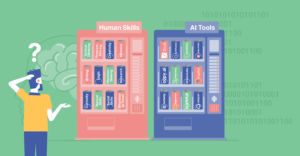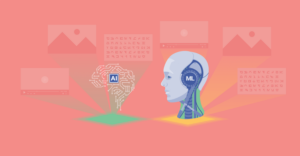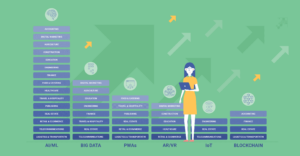In today’s rapidly evolving tech landscape, AI has become a catalyst for innovation, driving advancements in efficiency, automation, and strategic decision-making across a range of industries. Staying informed about the leading AI models and tools is crucial for maintaining a competitive edge and unlocking new business opportunities. As AI technologies continue to mature, they offer more scalable, powerful, and accessible solutions for real-world applications, from predictive analytics to advanced automation. This article will explore the top 5 AI models that are shaping the future of enterprise technology and driving digital transformation.

ChatGPT
Developed by OpenAI, ChatGPT is a conversational AI model that excels at generating human-like responses in real-time. It is widely used for automating customer service, enhancing user interaction, and even creative content generation. ChatGPT employs deep learning to understand context and provide coherent, relevant answers across a wide range of topics. Its applications span various industries, from education to enterprise support.
ChatGPT Background
ChatGPT was developed by OpenAI and launched in November 2022, making an instant impact. It is built on top of the GPT (Generative Pre-trained Transformer) architecture, which is based on deep learning techniques for natural language processing. The development of GPT models began in 2018, with GPT-2 and GPT-3 released in subsequent years. GPT-3, introduced in 2020, significantly advanced the model’s capabilities in text generation and understanding. ChatGPT utilises GPT-3.5 and GPT-4, becoming widely known for its ability to generate human-like conversational responses in real time.
Top ChatGPT Uses:
- Automated Customer Support
- Product Development
- Recommendations
- Content Generation
- Sales Support
- Lead Generation
- Conversational Uses
- Agents in ChatGPT
ChatGPT agents are specialised extensions that expand the core model’s functionalities by performing focused tasks autonomously. These agents can handle complex, multi-step workflows or answer queries across various fields, making them valuable in personalised customer support, in-depth research, and project management tasks. By distributing specific duties among agents, organisations can achieve efficient and scalable automation tailored to unique Uses. Agents can collaborate effectively, as in Agents Net (see below).
5 Most Popular ChatGPT Agents
- Customer Support Agent – Automates responses to common customer inquiries and escalates issues when necessary.
- Content Creator Agent – Assists with generating drafts, brainstorming ideas, and repurposing content for marketing or educational use.
- Project Manager Agent – Tracks progress, sends reminders, and updates teams on task statuses.
- Lead Qualification Agent – Engages with leads, answers questions, and qualifies potential clients before sales involvement.
- Research and Analysis Agent – Summarises findings, performs data analysis, and assists in report generation based on user needs.
Agents Net: A Collaborative Network of Autonomous AI Agents
One of the most important aspects of ChatGPT is Agents Net, a concept that envisions a network of autonomous ChatGPT agents working collaboratively to handle complex, distributed tasks. In this system, individual agents can specialise in specific roles (such as data analysis, customer support, or project management) and communicate seamlessly with each other to fulfil multifaceted goals.
Key Aspects of Agents Net
- Distributed Intelligence: Each agent in the network brings a specialised set of skills, so the collective intelligence of the network can cover diverse and complex needs. This approach allows for efficient task-sharing and ensures that each part of a project or query is allocated to and handled by the most qualified agent.
- Real-Time Collaboration: By allowing agents to share information, coordinate efforts, and collaborate in real-time, Agents Net achieves impressive levels of efficiency. For example, a lead-generation agent might pass customer details to a sales support agent, ensuring continuity across departments.
- Task Autonomy and Decision-Making: Each agent within the network can make decisions based on its specific knowledge area, while still considering input from other agents. This autonomy enables a flexible system that can adjust in real time to shifting priorities and complex requests.
- Scalability for Organisations: In larger organisations, Agents Net provides a scalable solution, with agents able to be added or customised according to specific workflows or departmental needs. This reduces overhead costs, as tasks can be automated and handled by different agents in parallel.
Practical Applications of Agents Net
Here are a few practical examples of situations in which Agents Net could be employed.
- E-commerce: From customer inquiries to handling complaints and managing inventory, different agents in an e-commerce network could seamlessly coordinate these tasks to ensure smooth customer experiences.
- Healthcare: In a healthcare setup, agents could assist with patient intake, manage records, provide appointment reminders, and even analyse data for research or diagnostics.
- Financial Services: In finance, Agents Net could help with compliance tracking, risk assessment, customer support, and transaction monitoring across various agents.
Agents Net opens up possibilities for highly collaborative and intelligent network systems, making AI adaptable to complex organisational ecosystems and applicable in dynamic, real-world contexts.
Claude
Claude is a safety-focused AI model designed to assist with tasks such as summarisation, content generation, and problem-solving. It is built with a strong emphasis on ethical considerations, minimising harmful outputs, and enhancing user control. Claude is positioned as a reliable assistant in environments in which AI ethics and safety are particularly paramount, such as research and business settings.
Claude Background
Claude was developed by Anthropic, a company founded by former OpenAI employees in 2021, and named after Claude Shannon, a pioneer of information theory. Claude is designed to provide safer and more reliable responses compared to existing models, integrating advanced language understanding whilst prioritising user alignment, making it ideally suited to the more sensitive language-based tasks.
Top Claude Uses:
- Automated Customer Support: Efficiently handling customer queries with safety and ethical considerations in mind.
- Content Summarisation: Offering quick, concise summaries of long-form content for easy consumption.
- Research Assistance: Helping researchers sift through data and generate insights with high accuracy.
- Product Development Insights: Providing recommendations based on data analysis for product improvement.
- AI-Enhanced Brainstorming: Supporting creative and technical teams with ideation and problem-solving.
- Task Automation: Automating routine tasks like scheduling or reporting with high accuracy.
Llama
Meta’s Llama (LLaMA; Large Language Model Meta AI) is an open-source large language model designed for research and enterprise use. It is optimised for performance and scalability, making it an appealing choice for those looking to integrate cutting-edge NLP (natural language processing) into their products. Llama is lightweight compared to some of its competitors, but still manages to offer powerful text generation and comprehension capabilities.
Llama Background
Llama was developed by Meta (formerly Facebook) and launched in early 2023. It is part of Meta’s effort to democratise AI research by providing a high-performance, open-source language model for use in research and development. Llama is designed to handle a wide range of natural language processing tasks, from research to automated content generation, offering an alternative to other large models such as GPT.
Top Llama Uses:
- Research and Analysis: Assisting researchers with advanced natural language understanding and data interpretation.
- Scientific Modelling: Offering insights and predictions based on vast datasets for academic and technical fields.
- Automated Content Creation: Generating high-quality text for technical and creative writing.
- Product Design Insights: Supporting engineers and product teams with data-driven suggestions.
- Text Summarisation: Streamlining long documents into concise summaries which are more easily digested.
Gemini
Gemini is an AI model designed for multimodal applications, combining the strengths of large language models with advanced image and video processing. Gemini excels in both text generation and understanding, as well as analysing complex data from different media types. This makes it a versatile tool for enterprises looking to deploy AI in diverse contexts including media, research, and content creation.
Gemini Background
Gemini is an advanced AI model developed by Google DeepMind. Released in 2023, it represents a leap in multimodal AI, designed to understand and integrate different types of data like text, images, and video. By bridging multiple data modalities, Gemini aims to push the boundaries of AI’s application in creative design, content generation, and data analysis, making it a versatile tool for industries that require comprehensive AI solutions.
Top Gemini Uses:
- Multimodal Understanding: Processing and integrating text, images, and video data for rich analysis.
- AI-Powered Creative Design: Assisting in generating unique visuals and creative concepts across various forms of media.
- Advanced Content Generation: Producing high-quality text and multimedia content.
- Data Analysis and Visualisation: Converting raw data into actionable insights using multimodal capabilities.
- Intelligent Recommendations: Offering suggestions based on complex inputs from various data types.
Mistral AI
Mistral AI’s speciality lies in developing state-of-the-art, open-weight models for natural language processing. Its approach combines high levels of efficiency with flexibility, allowing users to fine-tune models for various specific tasks. Mistral AI models can therefore offer high performance in a diverse range of contexts, from academic research to real-world enterprise applications.
Mistral AI Background
Mistral AI was founded in 2023 by a team of experienced AI experts. It focuses on developing high-performance, open-weight language models. These are designed for advanced AI applications in natural language processing and machine learning, offering flexibility and innovation to researchers and developers.
Top Mistral AI Uses:
- Natural Language Processing: Handling complex language tasks, including translation and text generation.
- Research and Development: Providing cutting-edge models for AI research and innovation.
- Data Analysis: Leveraging AI to interpret and process large datasets efficiently.
- AI-Assisted Creativity: Supporting creative industries with advanced text, image, and idea generation.
- AI Model Customisation: Offering flexible models for bespoke AI applications.

Conclusion
From chatty AI models like ChatGPT to all-rounders like Gemini that handle text, images, and more, it’s incredible to see how AI is transforming industries. Tools like Agents Net, with its collaborative AI networks, and flexible solutions like Mistral AI, show just how important adaptability and customisation have become. These technologies aren’t just tweaking workflows—they’re shaking up entire industries, giving businesses the tools to stay ahead and fully embrace innovation.



